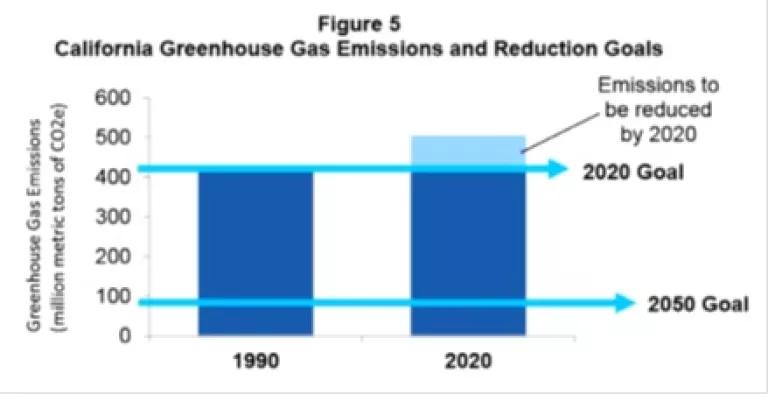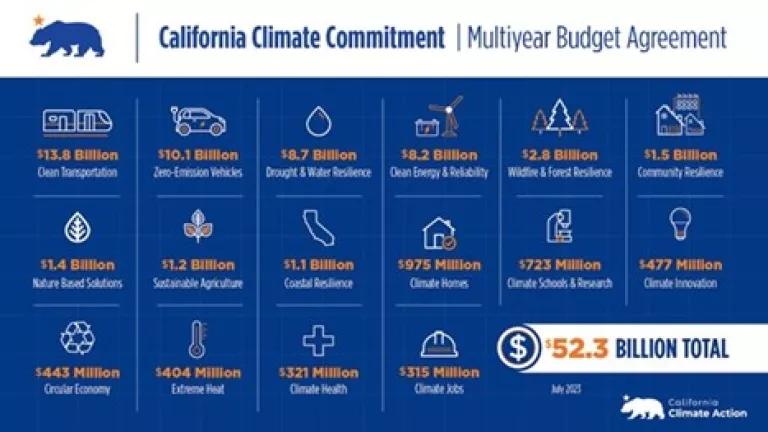Transformational Investment Plan Charts Course to Meet California's Clean Energy, Air Quality Goals
The California Air Resources Board will vote Thursday on a plan to invest the proceeds from the sale of carbon pollution allowances in transformational strategies and technologies to ensure the state meets its long-term climate and air quality goals and delivers those benefits to consumers.
The Air Resources Board has held two auctions of pollution permits to date (see hereand here) under the state’s cap-and-trade program, generating a combined $138 million to advance the goals of California’s Global Warming Solutions Act (AB 32). As a key component of AB32, the cap-and-trade program puts a firm limit on emissions from the state’s largest emitters but provides flexibility on how to comply, including the option to purchase allowances (essentially permits to emit one ton of carbon pollution) at quarterly auctions.
Under legislation signed into law last year, the Air Resources Board and the California Department of Finance are jointly tasked with developing triennial investment plans to submit to the Legislature on how to expend proceeds from the auctions. The Board last week released a draft of the first three-year plan, which calls for investments across sectors to meet California’s near-term and long-term reduction targets and make the benefits of AB 32 available to all Californians

Three Focus Areas
The investment plan focuses on three key sectors, outlined below, selected both for their significant carbon reduction potential and co-benefit opportunities, including local job growth, energy cost savings for consumers, and reduced criteria and toxic air pollutants. To deliver benefits quickly, the plan focuses funding in the early years on scaling up existing programs (a preliminary list of which is outlined in Appendix B).
- Sustainable Communities and Clean Transportation: As the largest contributor of both carbon and criteria air pollution in California, the plan recommends transportation sector strategies receive the largest allocation, including investments in sustainable transportation choices like biking, public transit, and walkable, mixed-use communities to implement California’s SB 375, cleaner vehicles and fuels, and the transportation infrastructure needed to support those technologies.
- Energy Efficiency and Clean Energy: The plan focuses on capturing energy efficiency opportunities in residential and public buildings, and in industrial and agricultural operations. Strategies include: scaling up innovative financing programs, expanding weatherization programs targeted at low-income households, and piloting energy efficiency retrofit programs at industrial facilities.
- Natural Resources and Waste Diversion: The plan also lays out a series of recommended strategies to reduce and sequester emissions from effective natural resource management. Strategies include: restoration and conservation easements for forestry and agricultural land and providing competitive grants to local agencies and businesses to expand and improve waste diversion and recycling.
To meet the Legislature’s commitment to ensure at least 25 percent of the proceeds benefit the state’s most disadvantaged communities (and 10 percent of the proceeds fund projects located in those communities), the Air Resources Board will employ a new tool developed by the California Environmental Protection Agency – the CalEnviroScreen – to identify areas in in the state disproportionately affected by air pollution and other socioeconomic criteria. Once identified as eligible, each recommended investment strategy will contain a tailored approach on how to direct projects and benefits into those communities. Appendix C contains regional maps showing the initial results of the screening tool for purposes of investment.
What’s Next
In May Governor Brown will release an update to the Fiscal Year 2013-2014 state budget proposing expenditure amounts under each category identified in the investment plan. The focus will then shift to the Legislature, which ultimately will make appropriations consistent with the plan through the annual budget (early indications suggest a warm welcome in at least half of the building).
The same day the Air Resources Board released the draft investment plan, the Pacific Legal Foundation – a conservative group with a steady track record of claiming victory for things like weakening protections for bald eagles – filed suit in Sacramento County Superior Court asserting, like the CalChamber before it, that ARB lacks the authority to auction allowances and the proceeds constitute an illegal tax. Much like the Chamber, the PLF would rather the value of allowances flow only to the large emitters covered under the program (or better yet, not flow at all).
While the timing of PLF’s suit has raised eyebrows (it could have been filed well over a year ago), it also presents a useful contrast to what’s outlined in the draft investment plan. On the one hand we have a blueprint for transformational investments in clean transportation, energy efficiency, and natural resource protection with special emphasis on co-benefits and our communities most in need. On the other: an endorsement of the status quo.
Which offers a better vision for California?
I’ll let you be the judge.



